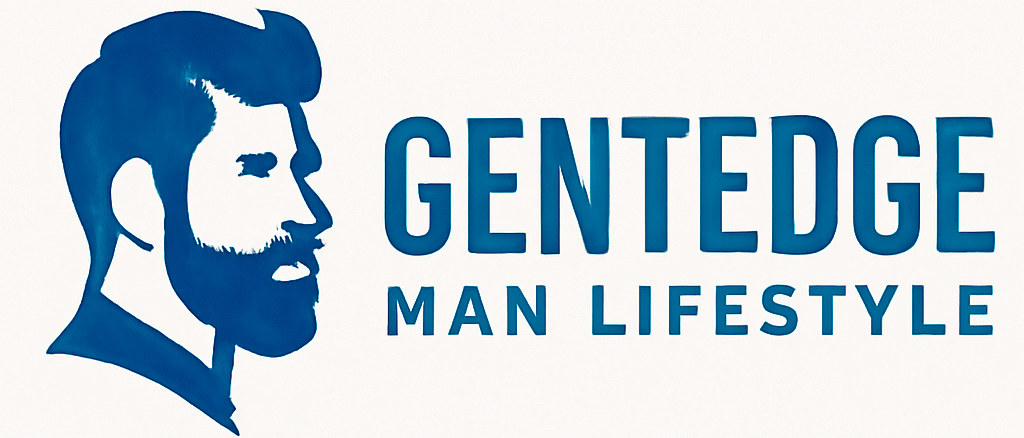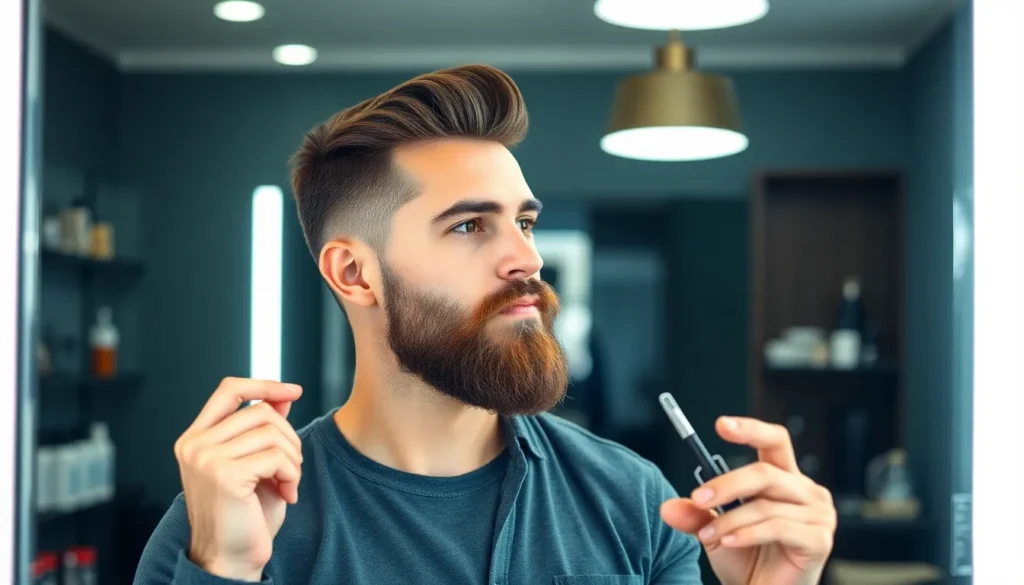The right beard cut can transform your entire look and boost your confidence like nothing else. Whether you’re sporting a full beard for the first time or looking to refresh your current style we’ve got the insights you need to find your perfect match.
Today’s men have more beard styling options than ever before. From classic cuts that never go out of style to modern trendy looks that make a bold statement there’s a beard style that complements every face shape and lifestyle. The key lies in understanding which cuts work best for your unique features and personal aesthetic.
We’ll walk you through the most popular beard cut styles that are dominating barbershops right now. You’ll discover professional techniques maintenance tips and styling secrets that’ll help you achieve that perfectly groomed look you’ve been wanting. Ready to unlock your beard’s full potential?
Classic Full Beard Styles That Never Go Out of Fashion
Some beard styles transcend fleeting trends and remain timeless choices for discerning men. These classic full beard options offer sophisticated looks that complement professional environments while maintaining masculine appeal.
The Traditional Full Beard
Traditional full beards represent the quintessential masculine aesthetic that’s dominated men’s grooming for centuries. We recommend maintaining 2-3 inches of length throughout the entire beard while keeping edges clean and well-defined. The mustache connects seamlessly to the beard without gaps, creating a unified appearance that frames the jawline naturally.
Regular trimming every 3-4 weeks ensures the traditional full beard maintains its classic proportions. Barbers typically use scissors for length control and clippers for edge definition around the cheeks and neckline. This style works exceptionally well for men with square or round face shapes, as the fuller coverage adds definition to softer facial features.
The Corporate Full Beard
Corporate full beards balance professional requirements with personal style preferences in modern workplace environments. We’ve observed this style gaining popularity among executives and business professionals who want to maintain facial hair without compromising their polished appearance. The length stays between 1-2 inches, with precise trimming along the cheek line and a clean neckline that sits just above the Adam’s apple.
Weekly maintenance appointments help corporate full beards retain their refined appearance. Professional barbers often use beard oils and balms to keep the hair soft and manageable while preventing the unruly look that can undermine business credibility. Men with oval or rectangular face shapes find this style particularly flattering for boardroom presentations and client meetings.
The Lumberjack Beard
Lumberjack beards embrace the rugged, outdoorsman aesthetic with fuller coverage and natural growth patterns. We’ve seen this style become increasingly popular among men who work in creative industries or prefer a more relaxed grooming approach. The length typically extends 3-4 inches or longer, with minimal trimming to preserve the beard’s natural shape and texture.
Monthly maintenance focuses on keeping the neckline clean while allowing the cheek line to grow naturally. Beard oils become essential for lumberjack styles, as the increased length requires more moisture and conditioning to prevent tangles and split ends. This robust style complements men with strong jawlines and angular features, creating an authentically masculine appearance that commands attention.
Short Beard Cuts for Professional Men

Modern workplace environments call for beard styles that project confidence while maintaining professionalism. These short beard cuts offer the perfect balance between masculine appeal and corporate appropriateness.
The 5 O’Clock Shadow
The 5 o’clock shadow represents the most subtle entry point into professional beard styling. This style maintains facial hair at the exact length it appears after one day’s natural growth, creating that signature late afternoon appearance that gives it its name.
Office environments particularly favor this low maintenance option because it delivers a clean cut appearance without appearing overly groomed. We recommend this style for men who want to add subtle masculine definition to their features while adhering to conservative workplace standards. The shadow effect works exceptionally well with business attire and requires minimal daily upkeep.
The Stubble Beard
The stubble beard extends slightly beyond the shadow stage, typically maintained between 1mm and 4mm in length. This versatile style offers more definition than the 5 o’clock shadow while remaining universally flattering across different face shapes.
Professional settings embrace this neat and polished look because it pairs seamlessly with various hairstyles and business attire. We find that most men can achieve this style with regular trimming every 2-3 days. The stubble beard strikes an ideal balance between rugged masculinity and workplace appropriateness, making it suitable for client meetings and office presentations.
The Short Boxed Beard
The short boxed beard defines itself through sharp, clean lines and maintains a maximum length of half an inch. This style covers the chin and jawline with precise, box like edges that create a distinct angular appearance.
Men with round or oval face shapes benefit most from this structured approach to beard styling. We recommend this cut for both casual and professional settings because its defined shape projects authority and attention to detail. Regular trimming becomes essential to maintain the sharp edges and geometric precision that characterize this style. The boxed beard requires dedicated grooming with quality beard trimmers and scissors to preserve its architectural appearance.
Trendy Goatee Variations for Different Face Shapes

Goatee styles offer incredible versatility for men seeking to enhance their facial features while maintaining a refined appearance. We’ve identified the most popular goatee variations that complement different face shapes and personal styling preferences.
The Classic Goatee
Classic goatees represent the perfect starting point for men new to facial hair styling. This timeless style features a small beard covering just the chin area, sometimes paired with a connected mustache for added definition. Maintaining this look requires minimal effort while delivering maximum impact on your overall appearance.
Most face shapes benefit from the classic goatee’s balanced proportions. Round faces gain angular definition, while square faces achieve softer contours through this strategic placement. We recommend keeping the length between half an inch to one inch for optimal visual appeal.
Trimming every 3-4 days keeps the classic goatee looking sharp and intentional. Use quality beard scissors or a precision trimmer to maintain clean edges around the chin line. Regular maintenance prevents the style from appearing unkempt or overgrown.
The Extended Goatee
Extended goatees create sophisticated length while maintaining professional standards. This variation stretches slightly beyond the traditional chin coverage, often connecting seamlessly with the mustache to form a cohesive facial hair frame. The extended reach provides more styling flexibility than its classic counterpart.
Round and square face shapes particularly benefit from the extended goatee’s lengthening effect. The additional coverage creates vertical lines that balance wider facial features and add visual height. Men with broader jawlines find this style especially flattering for creating proportion.
Weekly trimming sessions help maintain the extended goatee’s refined appearance. Focus on keeping the connection between mustache and beard smooth while preventing stray hairs from disrupting the clean lines. Quality beard oil keeps the longer hair soft and manageable.
The Van Dyke Style
Van Dyke goatees deliver distinctive character through their pointed bottom design. This sophisticated style features a detached mustache paired with a goatee that tapers to a sharp point at the chin. The separation between facial hair elements creates visual interest and artistic flair.
Oval and heart shaped faces showcase the Van Dyke style most effectively. The pointed goatee adds definition to softer chin lines while the independent mustache balances broader foreheads. This combination creates harmonious proportions across the entire face.
Precision trimming becomes essential for maintaining the Van Dyke’s dramatic silhouette. Shape the goatee point using small scissors, working gradually to achieve the desired angle. The detached mustache requires separate grooming attention to prevent unwanted connection with the beard area.
Designer Beard Styles for the Fashion-Forward Man
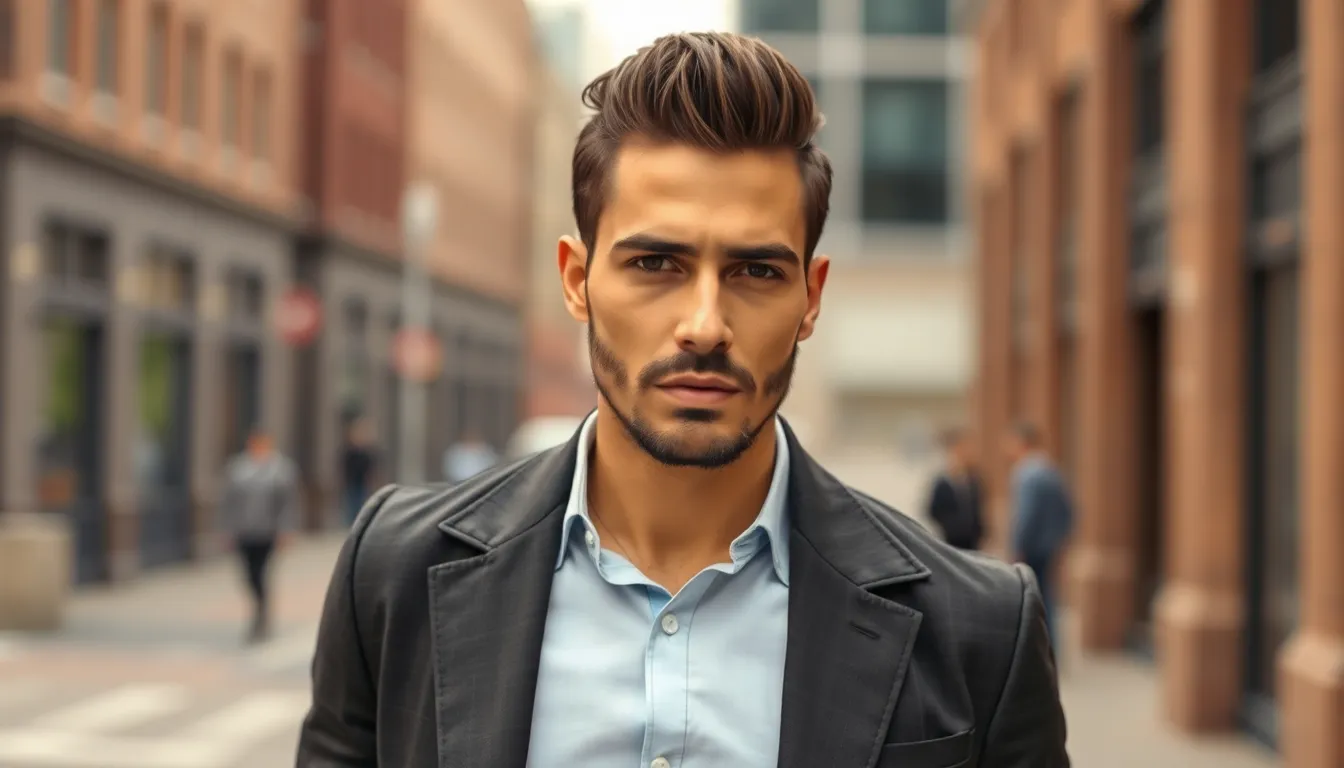
Fashion forward men seeking sophisticated beard styles can elevate their appearance with precision crafted designs that blend classic masculinity with contemporary flair.
The Ducktail Beard
Ducktail beards create dramatic focal points through important chin growth while maintaining trimmed sides and mustache areas. This distinctive style shapes the chin hair to resemble a duck’s tail, drawing attention to the jawline with its pointed finish.
Growing a ducktail requires patience as the chin hair typically reaches 2 to 4 inches in length before achieving the proper taper. Sides stay shorter throughout the process, while the mustache remains closely trimmed to differentiate this style from full beards or traditional goatees.
Maintenance involves regular shaping to preserve the structured appearance that defines this bold, masculine look. Men with strong jawlines find this style particularly flattering as it emphasizes angular features while adding a modern twist to their overall appearance.
The Anchor Beard
Anchor beards feature narrow, vertical growth along the jawline that connects to a small, pointed beard at the chin, creating the distinctive anchor shape. This precise style requires a thin, disconnected mustache to maintain clean separation between facial hair elements.
Regular maintenance keeps anchor beards sharp as the style demands consistent attention to preserve its geometric lines and polished appearance. Men who prefer unique, edgier profiles often choose this design for its sophisticated yet rebellious aesthetic.
Precision trimming defines the anchor style more than any other element, making it essential to visit skilled barbers who understand the technical requirements. This beard works exceptionally well for men seeking a conversation starter that combines classic grooming with contemporary edge.
The Balbo Beard
Balbo beards combine floating mustaches with chin focused growth that extends toward the jaw without connecting to the upper lip hair. This versatile style features squared or rounded chin beards that can be adapted to individual preferences and face shapes.
Versatility makes the balbo appealing to men who want sophisticated looks without extensive daily maintenance requirements. The disconnected design allows for creative customization while maintaining professional standards across various workplace environments.
Low maintenance requirements set the balbo apart from more complex designer styles, as the separated elements require less frequent touch ups. Most face shapes benefit from this style’s balanced proportions, making it an excellent choice for men experimenting with designer beard options for the first time.
Mustache and Beard Combinations That Make a Statement
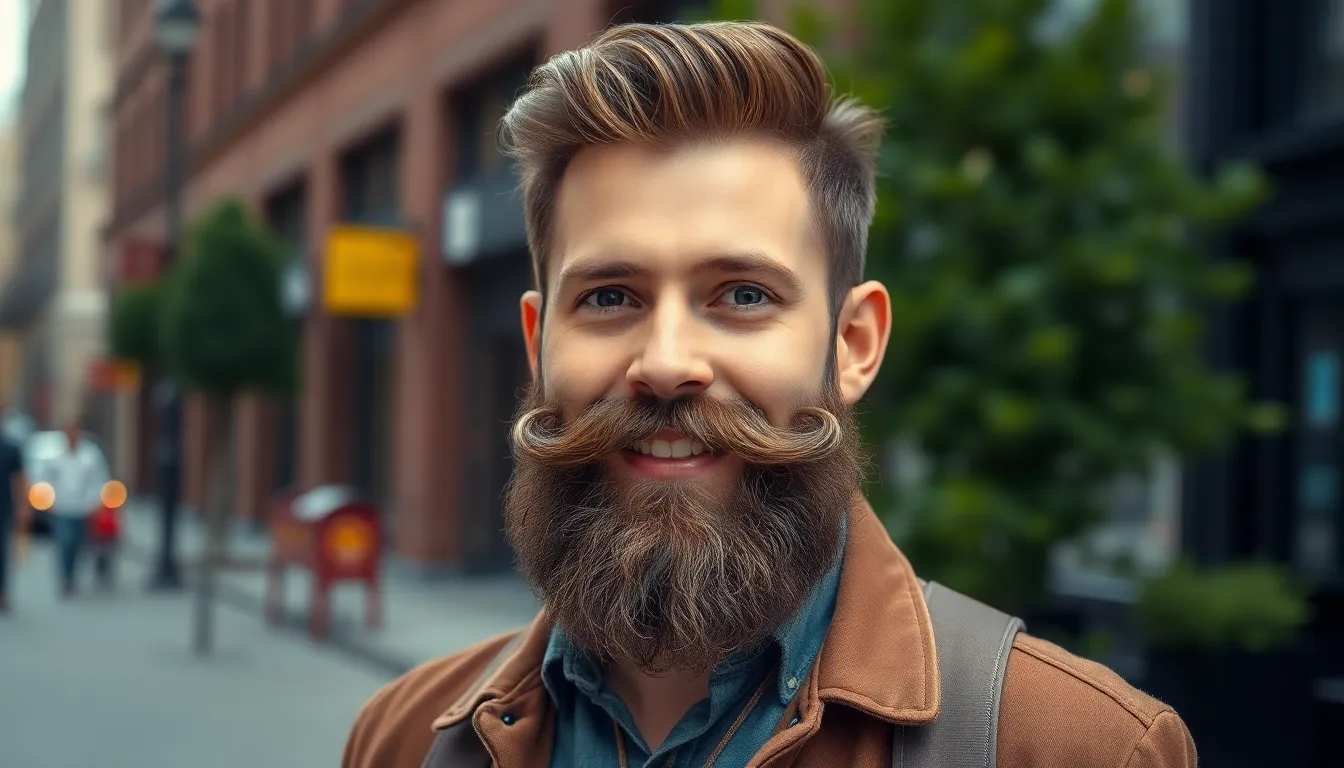
Combining mustache and beard styles creates distinctive looks that showcase your personality and grooming expertise. These powerful combinations transform facial hair into a defining feature that commands attention and respect.
The Handlebar Mustache with Full Beard
Handlebar mustaches with full beards deliver bold sophistication through their dramatic upward curls resembling bicycle handlebars. We recommend this combination for men seeking vintage appeal or hipster aesthetics that stand out in any crowd.
Styling Requirements:
- Mustache length extends beyond mouth corners for proper curling
- Wax application shapes the characteristic handlebar curves
- Full beard maintenance balances the mustache’s dramatic presence
- Daily grooming prevents unkempt appearance
Achieving this look demands dedication since both elements require consistent attention. The mustache ends need regular waxing and careful curling while the full beard benefits from trimming to complement the statement mustache above.
The Chevron Mustache with Trimmed Beard
Chevron mustaches paired with trimmed beards create classic masculine appeal through thick, straight lines above the upper lip. This combination works exceptionally well in professional environments where you want sophisticated edge without overwhelming drama.
Key Characteristics:
- Thick mustache sits directly above upper lip with squared ends
- Trimmed beard length ranges from short to medium for balance
- Clean edges around cheeks, chin, and neck maintain structure
- Professional appearance suits corporate settings
Maintaining this style requires regular beard trimming every few days to preserve the controlled contrast. The thick, well-defined mustache anchors the look while the neat beard provides masculine foundation without competing for attention.
The Horseshoe Mustache Style
Horseshoe mustaches make powerful statements through their distinctive downward extensions reaching past the mouth to the chin area. We call this the “biker mustache” because it projects rugged confidence and unconventional style preferences.
Distinctive Features:
- Long sides extend downward past mouth corners
- Clean-shaven chin option creates dramatic contrast
- Alternative pairing with small goatee adds complexity
- Dominant facial presence makes strong visual impact
Creating this look involves growing the mustache long enough for proper extension while keeping surrounding areas precisely groomed. The horseshoe shape dominates facial features, making it perfect for men who want their facial hair to serve as their signature style element.
Unique Beard Cut Styles for Creative Expression
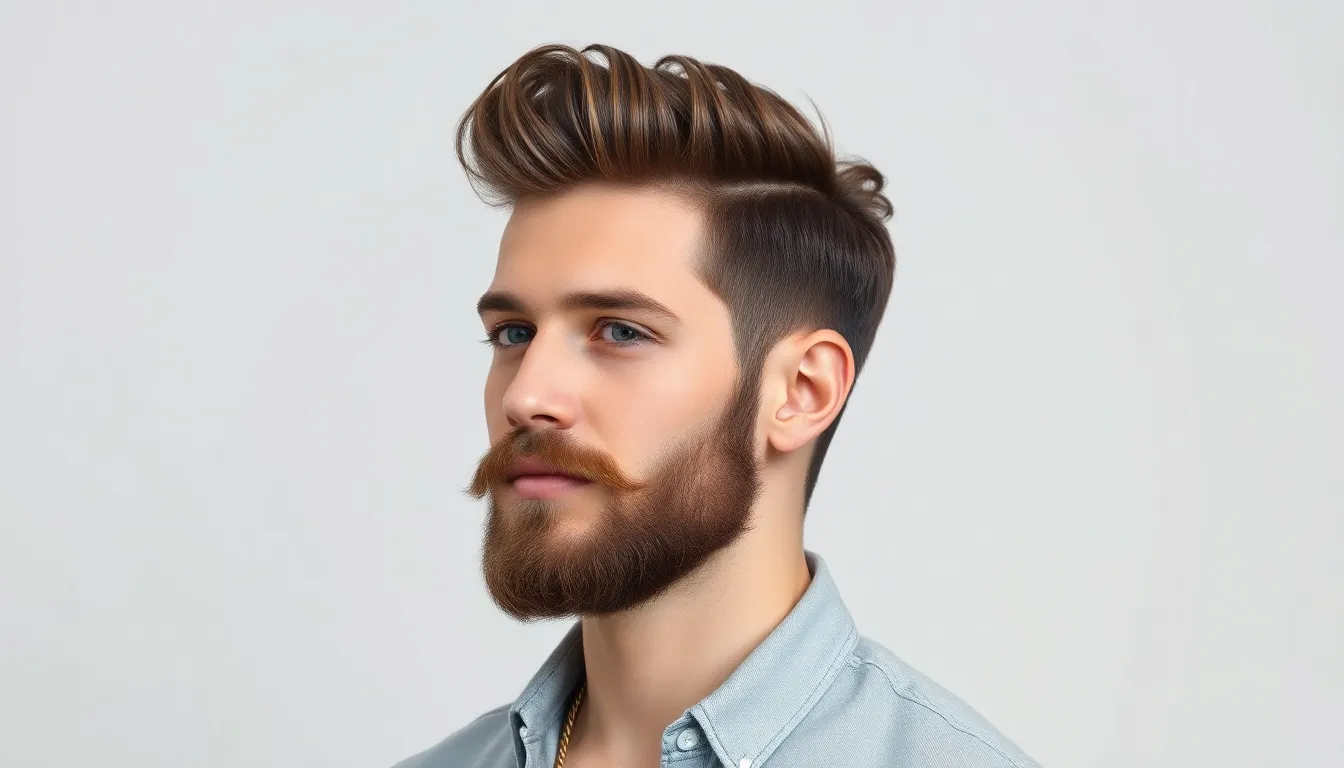
For those ready to push boundaries and showcase their individuality, these distinctive beard styles offer bold alternatives to conventional grooming.
The Mutton Chops
Mutton chops create a striking vintage aesthetic by featuring thick sideburns that extend to the corners of your mouth while keeping the chin area clean-shaven. This dramatic style transforms your facial profile and commands attention in any room.
Classic Mutton Chops deliver timeless sophistication through thick sideburns that stop before connecting to your mustache. We recommend this variation for men with square or oval face shapes, as it enhances natural bone structure without overwhelming facial features.
Friendly Mutton Chops offer more versatility by connecting your sideburns directly to a full mustache. This cohesive approach suits various face shapes and provides a more approachable appearance while maintaining the style’s distinctive character.
Wild Mutton Chops embrace untrimmed, bushy growth patterns that create maximum visual impact. Pairing these with a matching mustache delivers a bold statement that reflects confidence and rebellious spirit.
The Soul Patch
Soul patches provide subtle creative flair through a small, carefully maintained patch of hair positioned directly under your lower lip. This minimalist approach works exceptionally well as a standalone style or combined with other beard elements for added dimension.
Strategic placement of your soul patch creates focal points that draw attention to your mouth and jawline. We’ve observed that men often pair this style with goatees or mustaches to achieve more complex facial hair compositions.
Maintaining the soul patch requires precision trimming every few days to preserve its defined edges and compact size. Regular grooming ensures the patch maintains its intentional appearance rather than looking neglected or unplanned.
The Chin Curtain
Chin curtains frame your jawline through a distinctive band of hair that connects your sideburns along the bottom edge of your chin. This unique style avoids covering the chin itself, instead creating dramatic definition around your jaw’s natural contours.
Professional styling of chin curtains involves careful length management to ensure the hair band maintains consistent density from ear to ear. We recommend pairing this base style with mustaches or goatees to create more comprehensive beard designs.
Versatility makes chin curtains adaptable to different face shapes through strategic width and thickness adjustments. Round faces benefit from narrower bands that add vertical lines, while angular faces can accommodate fuller coverage that softens harsh edges.
Face Shape Considerations When Choosing Beard Styles
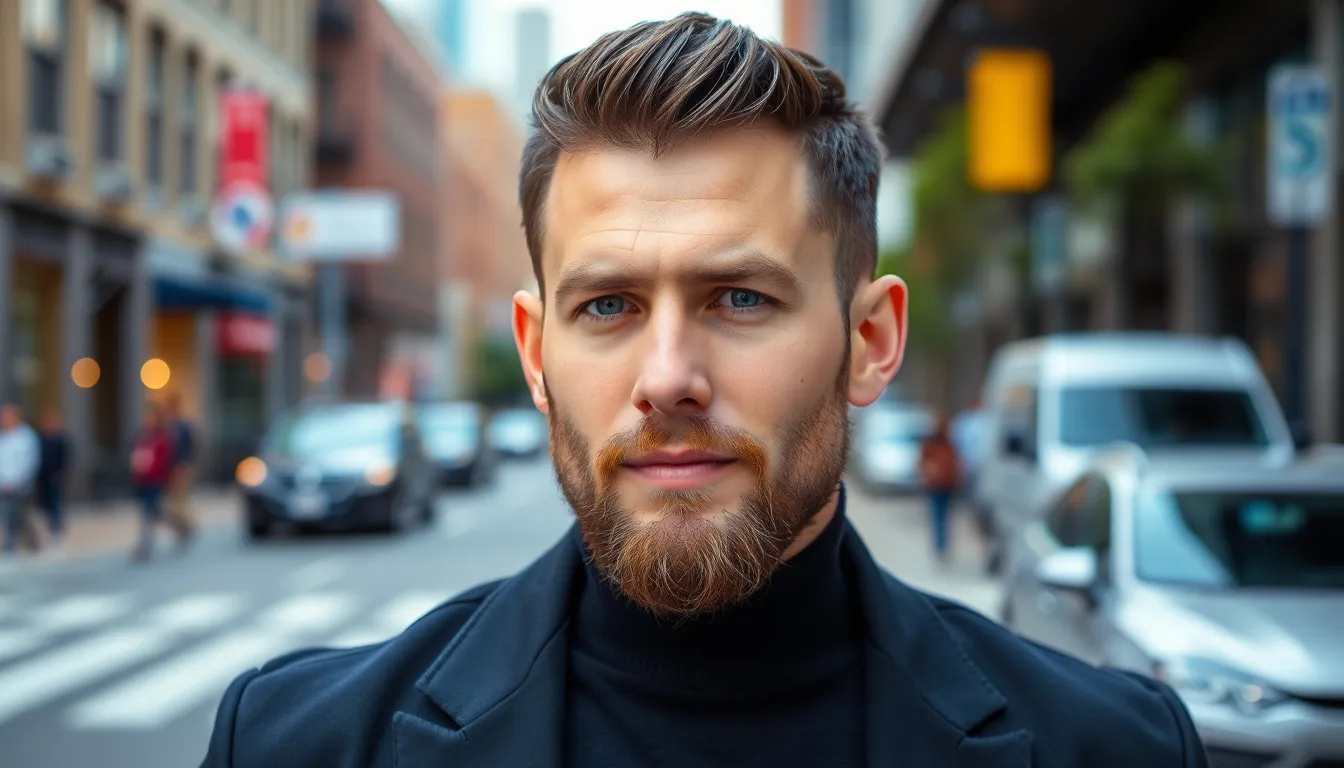
Selecting the right beard style transforms your appearance when you match it to your natural face shape. Understanding your facial structure helps you enhance your best features while creating visual balance.
Beard Styles for Round Faces
Round faces feature soft, curved jawlines and prominent cheekbones that create a gentle, circular appearance. Creating angular definition becomes essential for balancing these naturally soft features. Shorter styles on the sides combined with longer growth at the bottom work best for this face shape.
Short Boxed beards offer excellent structure by adding vertical lines that elongate your face. This style creates the illusion of a thinner, longer appearance while maintaining professional polish. Corporate beards provide similar benefits with their clean, geometric lines that sharpen your facial contours.
Avoiding styles that add width to your face prevents emphasizing the roundness. Full beards without proper shaping can make round faces appear wider than desired.
Best Cuts for Square Jawlines
Square faces showcase defined jawlines with equal width across the forehead, cheekbones, and jaw area. These angular features create natural masculinity that certain beard styles can enhance dramatically. Short stubble beards highlight your strong bone structure without overwhelming your natural definition.
Beardstache combinations work exceptionally well by drawing attention to your upper lip while keeping facial hair minimal. Short stubble maintains your jawline’s visibility while adding texture and depth. Classic Goatees focus attention on your chin area without covering your prominent jaw angles.
Circle beards create balanced proportions by softening harsh angles slightly while maintaining your masculine edge. Covering your jawline completely or adding excessive width diminishes your natural angular advantages.
Oval Face Beard Recommendations
Oval faces offer versatility with their balanced proportions between length and width measurements. This face shape accommodates nearly any beard style successfully, giving you freedom to experiment with different looks. Your natural facial harmony works with both structured and flowing beard designs.
Short Boxed beards complement your balanced features while adding sophisticated definition. Stubble variations like the Beardstache enhance your natural proportions without overwhelming your face. Goatee styles work particularly well by adding focus to your chin area.
Verdi beards offer dramatic flair for oval faces seeking bold styling options. Your face shape’s natural balance supports both conservative and adventurous beard choices effectively.
Maintenance Tips for Different Beard Cut Styles
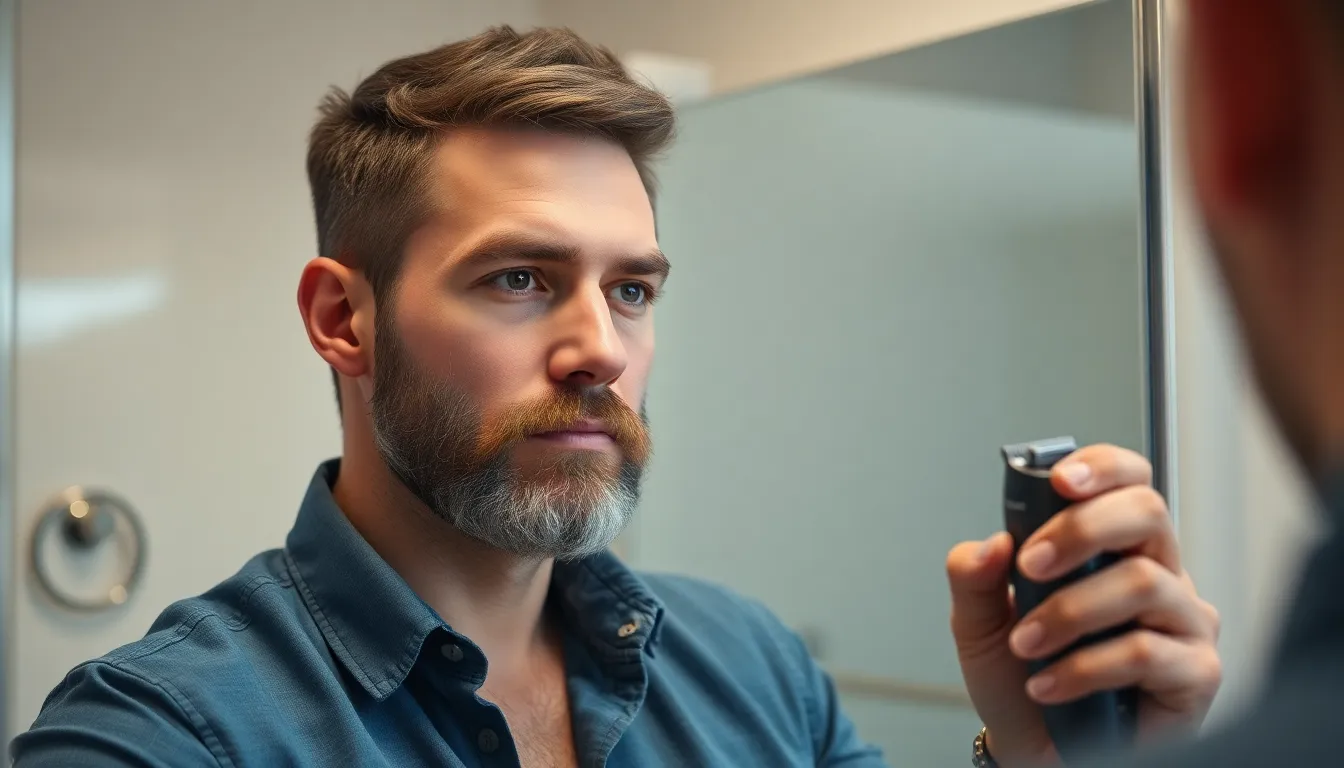
Proper maintenance ensures your chosen beard style continues looking sharp and well-groomed. We’ll explore the essential grooming practices that keep every beard cut looking its best.
Daily Grooming Routines
Morning preparation sets the foundation for a polished beard appearance throughout the day. We recommend applying beard oil or balm immediately after washing to keep facial hair healthy and moisturized. This daily ritual prevents dryness and maintains the natural oils your beard needs to stay soft and manageable.
Evening maintenance involves gentle brushing with a quality beard comb to remove tangles and distribute natural oils evenly. Cleansing your beard with a dedicated beard shampoo removes accumulated dirt and styling products from the day. Regular inspection during your evening routine helps identify areas that need attention or trimming.
Weekly deep conditioning treatments provide intensive moisture for longer beard styles like the Lumberjack or Traditional Full Beard. Apply a beard mask or leave-in conditioner once per week to maintain optimal beard health. Gentle exfoliation of the skin beneath removes dead skin cells and prevents ingrown hairs.
Essential Beard Trimming Tools
Beard trimmers serve as the primary tool for shaping and maintaining length across all beard styles. Quality electric trimmers with adjustable guards allow precise control over length settings from stubble to full beard dimensions. Cordless models provide flexibility during grooming sessions and typically offer 45-60 minutes of runtime per charge.
Precision razors define clean edges and remove excess hair around the neckline and cheek areas. Safety razors deliver superior control for detailed work around the mustache and goatee regions. Disposable cartridge razors work well for quick touch-ups and maintaining sharp lines.
Professional clippers create clean lines and trim areas that standard trimmers cannot reach effectively. Barber-grade clippers offer powerful motors and sharp blades for consistent results. Hair scissors complement clippers for detailed trimming and removing individual long hairs that escape regular trimming.
Specialized combs guide cutting tools for even results and help detangle beard hair before trimming. Wide-tooth combs work best for longer beard styles, while fine-tooth combs suit shorter styles like stubble and 5 O’Clock Shadow. Boar bristle brushes distribute oils and provide gentle styling for daily grooming.
Professional vs. DIY Maintenance
Professional grooming delivers precise shapes and expert styling that’s difficult to achieve at home. Experienced barbers understand face shape considerations and can recommend modifications to enhance your chosen style. Professional services typically cost $25-50 per session and provide results that last 2-4 weeks depending on your beard’s growth rate.
DIY maintenance offers convenience and cost savings while allowing complete control over your grooming schedule. Learning proper techniques takes practice, but most men can master basic trimming within 2-3 attempts. Home grooming requires an initial investment of $50-150 in quality tools, but saves money over time compared to regular professional visits.
Hybrid approaches combine professional shaping with home maintenance for optimal results. Schedule professional appointments every 4-6 weeks for precise shaping and style adjustments. Maintain the professional cut at home with daily grooming and weekly touch-ups using proper techniques and tools.
Conclusion
We’ve explored a comprehensive range of beard cut styles that cater to every man’s unique preferences and lifestyle needs. From timeless classics to bold designer options each style offers its own distinct character and maintenance requirements.
The key to successful beard styling lies in understanding your face shape and choosing cuts that enhance your natural features. Whether you prefer the rugged appeal of a lumberjack beard or the refined sophistication of a corporate style there’s a perfect match for your personal aesthetic.
Remember that consistent maintenance and quality grooming products are essential for achieving professional results. With the right approach and dedication you’ll master the art of beard styling and enjoy the confidence that comes with a perfectly groomed appearance.
Frequently Asked Questions
What is the best beard length for a professional workplace?
For professional environments, keep your beard between 1-2 inches in length. The Corporate Full Beard and Short Boxed Beard are excellent choices as they maintain a polished appearance while projecting confidence. Regular trimming every few days ensures clean lines and prevents an unkempt look that might be inappropriate for conservative workplace standards.
How often should I trim my beard to maintain its shape?
Trimming frequency depends on your beard style and growth rate. Short styles like stubble require trimming every 2-3 days, while longer styles like the Traditional Full Beard need weekly maintenance. Designer styles such as the Anchor Beard require more frequent precision trimming to maintain their structured appearance and clean lines.
Which beard style works best for round face shapes?
Round faces benefit from styles that create angular definition and add length. The Short Boxed Beard, Corporate Full Beard, and Classic Goatee are ideal choices as they provide sharp lines and geometric structure. Avoid styles that add width to the sides, and focus on beard cuts that emphasize vertical lines and chin definition.
What’s the difference between a goatee and a full beard?
A goatee covers only the chin area and may include a connected mustache, while a full beard covers the entire lower face including cheeks, jawline, and neck. Goatees offer easier maintenance and a more refined appearance, while full beards provide maximum coverage and a more masculine, rugged look requiring more extensive grooming.
How do I maintain a handlebar mustache with a full beard?
Daily styling with mustache wax is essential for maintaining the handlebar’s distinctive curls. Use a fine-tooth comb to separate and shape the mustache while applying beard oil to the full beard portion. Regular trimming of the beard and careful grooming of the mustache ensures both elements complement each other for a sophisticated appearance.
What tools do I need for proper beard maintenance?
Essential tools include a quality beard trimmer with multiple guards, precision scissors, a fine-tooth beard comb, and a boar bristle brush. Add beard oil or balm for daily conditioning, mustache wax for styling, and a sharp razor for clean edge work. Professional-grade tools ensure better results and longer-lasting maintenance.
Can I change my beard style frequently or should I stick to one?
You can change beard styles, but consider the growth time required for transitions. Moving from short to long styles requires patience, while going from long to short is immediate. Some styles like the Van Dyke or Balbo require specific growth patterns, so plan transitions carefully and consider consulting a professional barber for dramatic changes.
How long does it take to grow a full lumberjack beard?
A full Lumberjack Beard typically takes 3-6 months to achieve the desired 3-4 inch length, depending on your natural growth rate. This style requires minimal trimming during the growth phase, focusing instead on regular conditioning and brushing to maintain healthy hair and prevent tangling as it develops its characteristic rugged appearance.
